About Groups
Contents
This section describes how Poser differentiates between body part groups, material groups, and other group types on a figure or prop. This explanation is specific to Poser, however it will provide you with the background information you need in order to understand groups in general.
The following examples use the Alyson Casual figure (available in the Figures category). Add this figure to your scene by dragging from the Library to the document window, or by clicking the Change Figure or Create New Figure button at the bottom of the Library palette, as described in Loading and Managing Items using the Library Icons . When you display the figure in Outline display mode and hover your mouse over the various body parts, you’ll see an outline of the group underneath the mouse. We have color-coded the groups for clarity in the following figure.
Please remember that each figure/prop is different, having different body parts, materials, hair, and cloth groups. Further, the groups themselves may be arranged in different orders. However, the concepts explained here are the same for each figure/prop.
Poser figures consist of named body parts that can be selected and articulated (or posed). Props normally consist of a single part that cannot be articulated, although poseable props do exist. The following graphic depicts an example of Poser body parts:
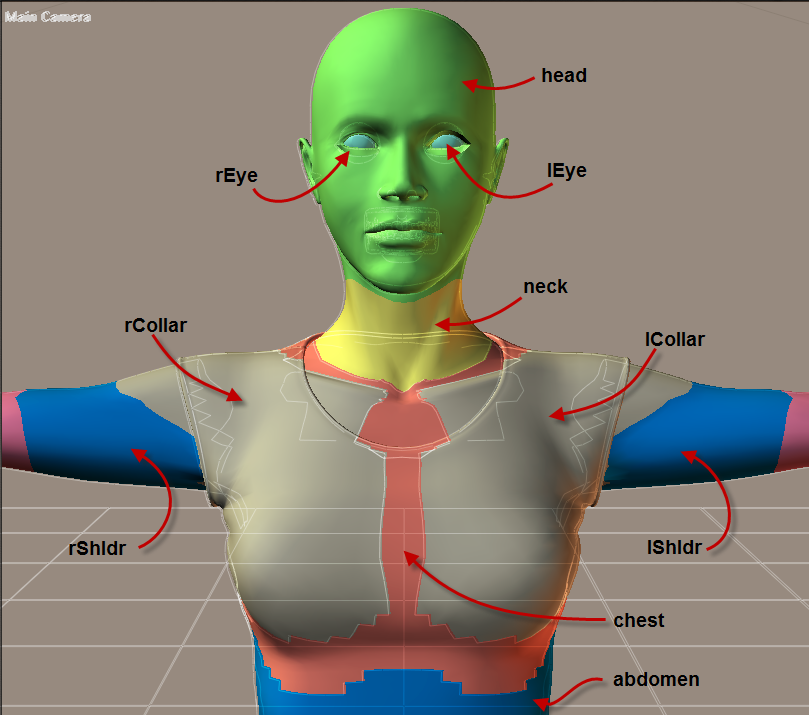
A figure is made up of poseable body parts, called groups.
The example displays several body parts: head, left eyeball, right eyeball, neck, chest, left collar, right collar., left shoulder, right shoulder, and abdomen Each of these body parts can be articulated (posed).
Each body part (or group) consists of one or more polygons.
As hinted above, there are several different types of polygon groups: body part groups, material groups, hair groups, and cloth groups for example. A polygon can belong to more than one type of group (such as a body part group and a material group, or a cloth group and a material group). A polygon can only be in one group of each type at a time. Thus, the following group combinations are possible:
- One body part may have one material assigned to it. For example, the neck will probably have the “skin” material.
- Two or more body parts may use the same material. For example, the fingers may all use the “skin” material.
- One body part may use more than one material. For example, each eyeball may have separate materials for the eyeball, iris, and pupil.
- In addition to the above, a polygon may be part of a hair group and/or a cloth group.
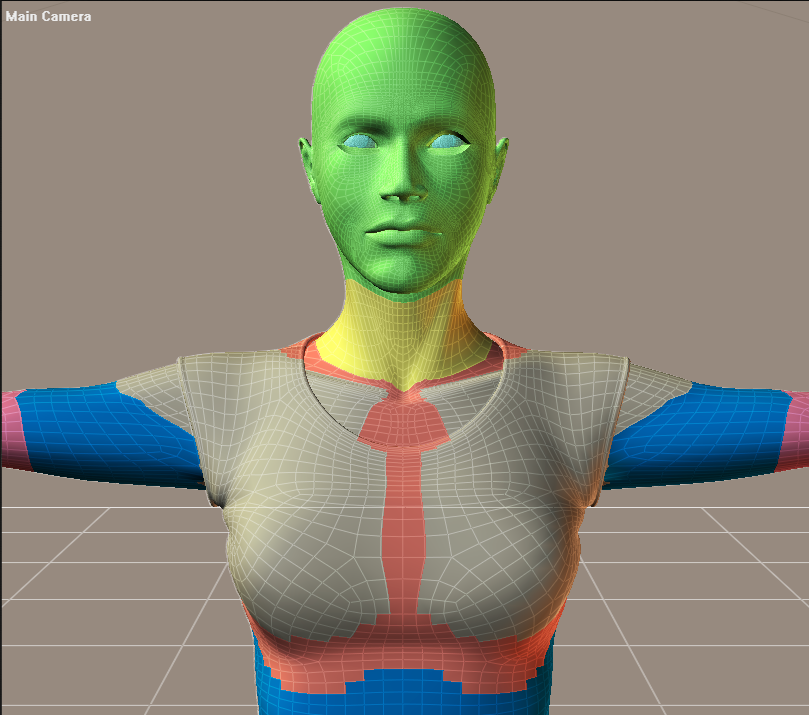
Polygons in the figure are assigned to groups for posing.
Since body parts and materials are the most obvious forms of grouping, let’s use them to illustrate grouping as a whole since the same concepts apply to hair and cloth groups as well. The graphic displays the material assignments for the above-displayed body parts.
You can see that the head, neck, and portions of the chest use the skin material. The chest and collars use the shirt material. The eyes use eyeball, pupil, and iris materials. The head uses several materials including skin, lips, and eyebrows.
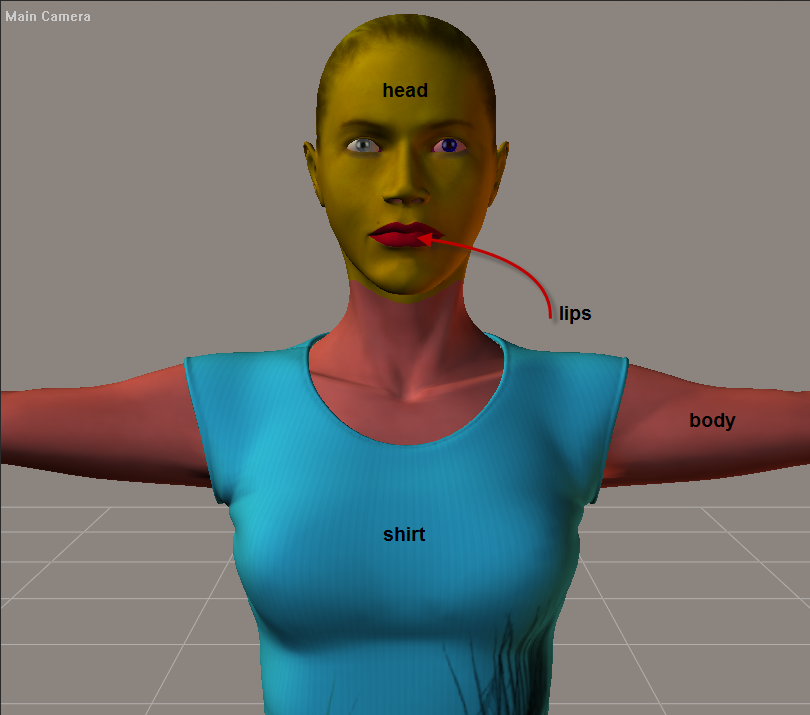
Material assignments for various body parts.
The important things to remember are:
- Poser groups polygons by body part, material, hair, and cloth, and these groups are independent of each other.
- Each material in a figure/prop gets assigned a unique numbered ID, and that ID is in turn used by a polygon to specify which material should be applied to that polygon. For example, the skin material may have ID 1, the shirt ID 2, etc. Each polygon in a figure/prop includes the ID number of the material assigned to that polygon. Changing a material itself will affect the appearance of all polygons that have the corresponding material ID. For example, if one made the skin green, then all polygons with the “skin” material ID would turn green regardless of the body part.
The following table depicts a partial list of the relationships between body parts and materials in the Alyson Casual figure:
| Body Part | Assigned Material(s) |
| Head | Head, Nostrils, Lips, EyeSockets, Lacrimals, InnerMouth, TearLine, EyelashesBottom, EyelashesTop, Teeth, Gums, Tongue |
| Eyeballs (left and right) | EyeballLeft, IrisLeft, PupilLeft, CorneaLeft, EyeballRight, IrisRight, PupilRight, CorneaRight |
| Neck | Body |
| Collars (left and right) | Body, Shirt |
| Chest | Body, Shirt |
Again, the only relationship between the body parts, materials, hair, and cloth is that defined by the figure’s creator. Poser does not mandate any such relationship.
Now that we have differentiated between body part and material groups and mentioned hair and cloth, let’s describe hair and cloth groups in more detail:
Hair Groups
Hair groups are groups of polygons that can also belong to any body part, prop, and material group. Polygons that are part of hair groups can have real 3D hair grown on them. Please refer to The Hair Room for more information about the Hair room.
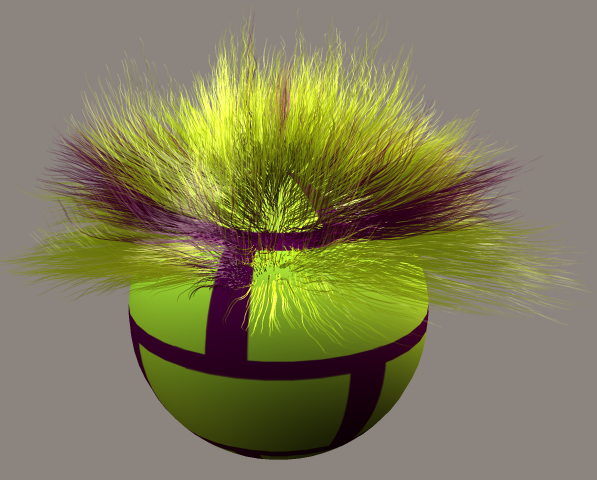
Hair groups are special grouping assignments that can grow strand-based hair.
Cloth Groups
Poser’s Cloth room allows you to create realistic cloth that you can use for almost any purpose in your scene. Cloth groups are actually vertex groups, meaning that they are groups of vertices instead of polygons, however this makes little difference in the overall discussion. Vertices belonging to a cloth group cannot belong to a body part group.
Here is an example of a figure wearing dynamic cloth, which consists of props with named groups. See how the cloth realistically drapes and moves as the figure moves.
Please refer to The Cloth Room for more information about the Cloth room.
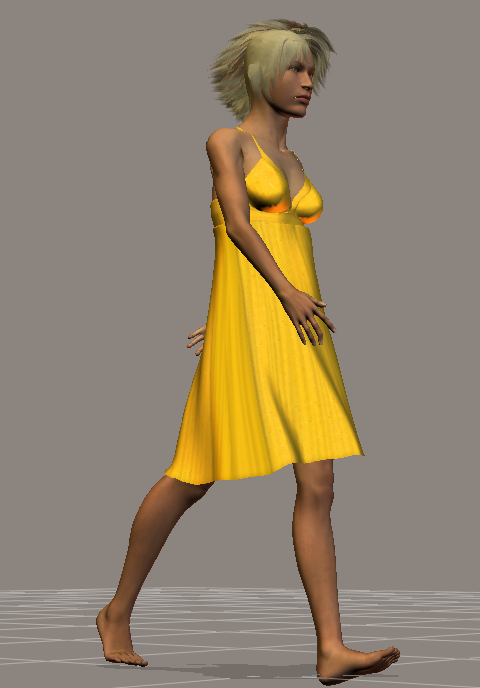
Cloth groups are used in dynamic clothing, which moves realistically when animated.